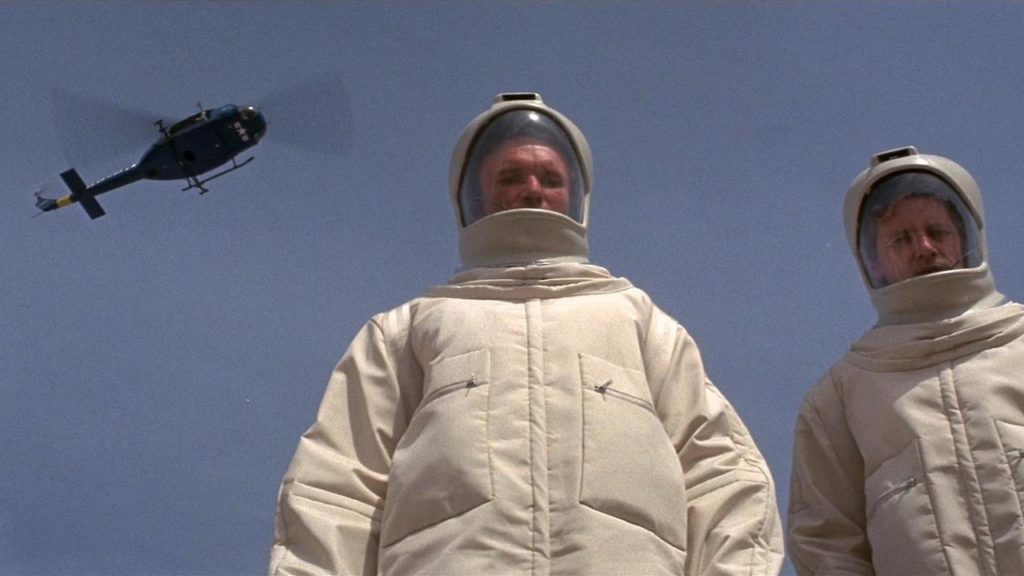The Andromeda Strain (1971)

Michael Crichton’s 1969 sci fi-thriller novel of the same name serves as the basis of this film, which jumped into production not long after the book’s release. It starts off in the town of Piedmont, where a small Southwestern US community has ostensibly perished for reasons unknown. The military is called in and discovers that all but two, an old man and a baby, are dead from some sort of affliction which crystallized the blood of the people and animals there. A group of scientists are called together to a top secret underground testing facility to check on the satellite which may have brought the deadly compound down to Earth. With days, or even hours, before a massive pandemic outbreak results, the scientists must discover just what is killing people so quickly, what kept the survivors alive, and what, if anything, can be done to stop the organism that came from outer space.
With a large amount of money going to set design and computer graphics, and given the cerebral nature of the story-line, The Andromeda Strain would be a risky venture for the producers, especially given that there are no big stars attached. In this way, it resembles Stanley Kubrick’s 2001: A Space Odyssey, although the scope isn’t so much about the beauty of space beyond our atmosphere as it is the deadliness of space if it should encroach into our own. Part thriller, part disaster movie, Robert Wise’s (The Sound of Music, Star Trek) film taps into many prevailing fears of the time, including nuclear detonation, chemical warfare, government cover-ups, and scientific experimentation gone amok. These fears haven’t gone away, making The Andromeda Strain a worthwhile story for today’s viewers, so long as you can overlook the dated aspects of the technology of the time it was made.
Although competently made, I would hedge my recommendations strictly to those who enjoy science fiction and “thinking person” thrillers, as the build-up is long and without much action. You have to be fascinated with how scientists and the military operate in times of crisis, and find such things as the decontamination process and lab testing to be suspenseful. At 131 minutes, it’s not a short film by any means, and certainly it could have been trimmed from a story standpoint in order to maximize the efficiency of the thriller aspects, but I personally think it would come at the some cost of the intelligence of the process itself. It’s fascinating to see scientists at work to solve a problem in a small area that could potentially save the lives of millions, if not billions of people.
The screenplay by Nelson Gidding (The Haunting, Beyond the Poseidon Adventure) stays mostly faithful to its source material, which is laudable given the fact that it would have originally seemed to most writers to have been unfilmable without injecting a great deal of action. Credit director Wise for injecting a good sense of visual style to the proceedings, and in not dumbing down the execution in favor of cheap theatrics and clichéd plot developments. Good use of the widescreen process helps, with choice Oscar-nominated editing and a sparse electronic soundtrack by Gil Melle (The Sentinel, The Deliberate Stranger) that gives us a sense of the synthetic and alien themes of the storyline. The legendary Douglas Trumbull (Silent Running, Close Encounters) enhances the visual appeal with believably futuristic special effects.
It’s interesting to see a film about a space alien that doesn’t resemble anything we’ve ever seen before, as most others have some sort of humanoid appearance, (or reptilian, etc.) Indeed, it’s a much more plausible depiction of an alien threat than most other sci-fi efforts have featured, almost the opposite in terms of story as The War of the Worlds which featured aliens defeated from exposures to germs and viruses of our own. It’s also interesting for depicting how fragile the continued existence of life on Earth is when a simple microscopic life form can quickly regenerate and spread, causing potential calamity to anyone unlucky enough to come into contact with it. The lifesaving measures employed by the government also end up being the one thing that might potentially kill us all, making the nuclear blast climax of the film all the more harrowing. It’s a film that disturbs on a level beyond just the action at hand.
— Soon to be remade into a TV mini-series in 2008 on A&E.
Qwipster’s rating: A
MPAA Rated: G (probably PG-13 today for disturbing images, innuendo, and some language)
Running time: 131 min.
Cast: Arthur Hill, David Wayne, James Olsen, Kate Reid, Paula Kelly, George Mitchell
Director: Robert Wise
Screenplay: Nelson Gidding (based on the novel by Michael Crichton)
